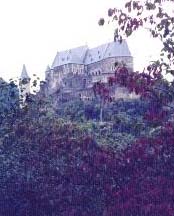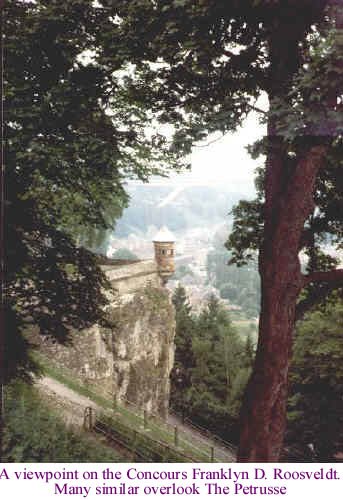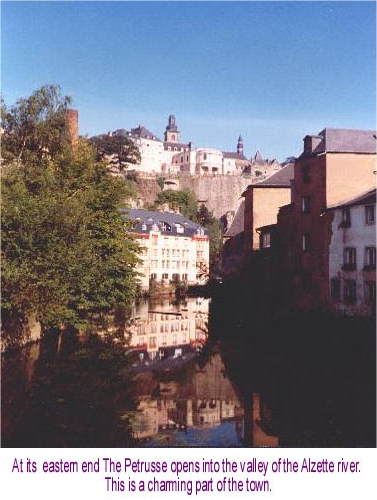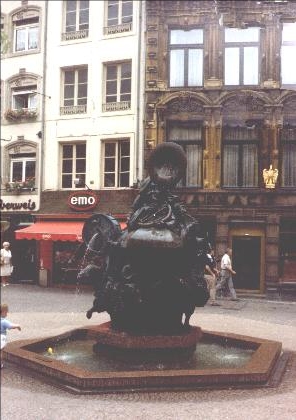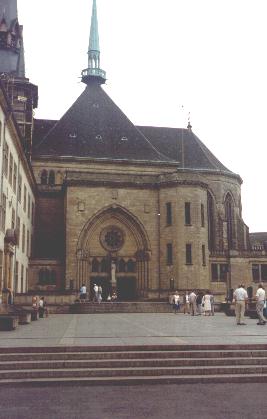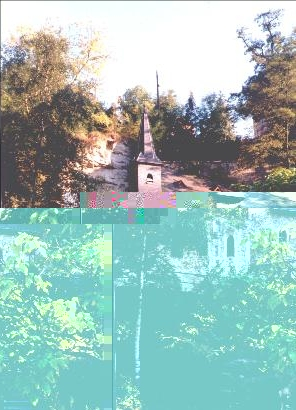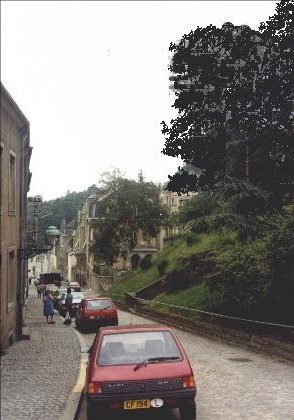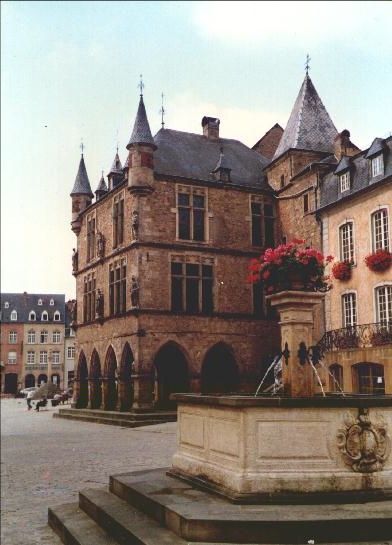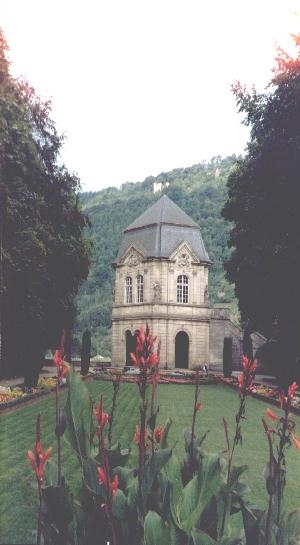
An ideal short - break destination not considered by many is Luxembourg. Though tiny in area The Grand Duchy is huge in history and when the tourism office describe it as The Crossroads of Europe they are not exaggerating. The Gothic heritage is obvious everywhere, even the landscape seems to have that dramatic moodiness we associate with the dark romances of ninteenth century literature. 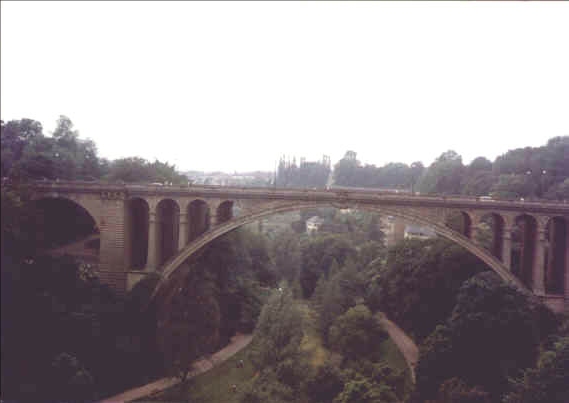 Arriving in Luxembourg City from France visitors pass through the suburbs and the "new town" before crossing a chasm called The Petrusse into the Old Town via the Pont Adolph (many of Luxembourgs Grand Dukes have been called Adolph.) The ancient settlement stands on a rock promontory , the Bock and The Petrusse is the feature that made it an almost impregnable fortress for many centuries. A stream that runs along the floor of the chasm is also called The Petrusse and is so tiny it could easily be jumped by a reasonably fit person. One cannot help but wonder what kind of geophysical forces carved such a rent in the landscape.
Arriving in Luxembourg City from France visitors pass through the suburbs and the "new town" before crossing a chasm called The Petrusse into the Old Town via the Pont Adolph (many of Luxembourgs Grand Dukes have been called Adolph.) The ancient settlement stands on a rock promontory , the Bock and The Petrusse is the feature that made it an almost impregnable fortress for many centuries. A stream that runs along the floor of the chasm is also called The Petrusse and is so tiny it could easily be jumped by a reasonably fit person. One cannot help but wonder what kind of geophysical forces carved such a rent in the landscape.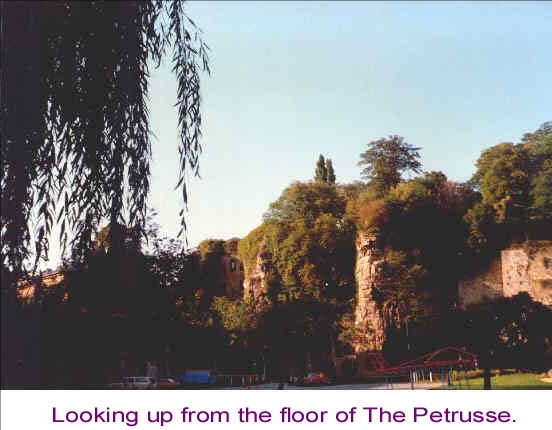
There are many walks in the Petrusse which if you are feeling energetic may be accessed from the Boulevard Franklyn D. Roosveldt, a concourse that runs along the top of the 300 foot cliff, via a stone staircase. There is a day long lift service too.
The landscaped gardens with their fountains and playgrounds are ideal for a leisurely stroll. It really is a different world to the one some people know. One day I was standing in one of the niches enjoying the view when an American girl standing nearby said "I would sure love to walk down there, its so beautiful." Seeing she had a heavy backpack I suggested the lift. "Oh no, she said, I could get down the steps but it would not be safe, look at all those tress and bushes. You don't know who could be hiding in there." I tried to assure her that Luxembourg was not a bit like Central Park but she would not be swayed and when I offered to be her escort she accused me of being a pervert. And she was not even very good looking. The cheek! The girl would have been quite safe on her own of course, its a sad world when travellers have to take their fears everywhere they go. 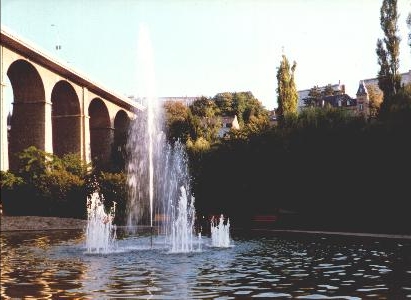
Above: A fountain in the gardens of The Petrusse.
The town has much more to offer than can be seen in this particular corner. Walk around the narrow streets and you will be delighted by the many surprises like the fountain in Place de Theatre depicting an oompah band. The Luxembourgois love music and beer and there are many bars and bierkellers where you may hear anything from traditional Germanic tunes to jazz and rock. Accompany that with the excellent local beer which is brewed under strict purity laws and good food on offer and you have the makings of many wonderful nights. The Place de Theatre (above, left) is very central and as well as the intriguing fountain of the musicians has plenty of restaurants offering many national cuisines as one would expect in such a cosmopolitan city. To the extreme right of the picture above is my favourite restaurant, the Italian menu offered good value and the informal atmosphere made it a fun place to eat. My hotel was just around the corner in the Rue de Remarques (ahem, sorry I couldn't resist) The fountain symbolises the sheepmarket which was held here from medieval times to the nineteenth century. Please don't ask me what the band has to do with sheep.
Two minutes walk from the Place de Theatre is the Cathedral, Notre Dame de Luxembourg. (above right) Though not as spectacular as the famed Notre Dame de Paris or the great Gothic Cathedrals in Britain and bigger European states it is a charming place to visit either for sightseeing or to spend a contemplative hour. The Cathedral, originally a Jesuit church was built between 1613 and 1618 and although there has been some rebuilding the original design is unchanged. The crowded nature of Luxembourg city makes it difficult to get a clear photograph of the whole building. Though essentially Gothic in its exterior appearance the interior of the church is heavily influenced by renaissance thinking.
After a tour of the Cathederal we emerge from the front entrance into the Rue Notre Dame and if turn right into the Rue de la Fosse, a street that follows the route of an 11th century ditch another short stroll (nowhere is far from anywhere else in Luxembourg) brings us to the Place Guillaume, a large square which has at its centre a magnificent equestrian statue of King William II of the Netherlands and Grand Duke of Luxembourg who founded the present Royal House. Below that the Palace which houses the Royal Apartments and the Parliament chambers is pictured.
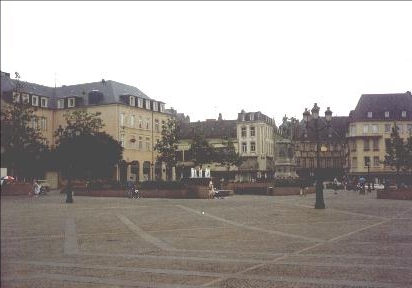 
A feature many people will want to visit are the Casements, a network of man made tunnels hewn out of the bedrock under the bock and linking many defensive positions like the one pictured above, right. The plateau on which the old town stands was known in the medieval period as The Plateau of The Holy Ghost and beneath it is the fortress of the Holy Ghost. A large central chamber under the Place Guillaume links 15 miles of subterranean routes which lead to the many fortifications and redoubts (The Casements) around the Bock. The central chamber is now an underground car park beneath the Place Guillaume but the tunnels and many small chambers have been made safe and are open to the public. The casements were first fortified by the Teutonic Knights in 1335 as they prepared to defend the city against the Duke of Burgundy. The Burgundians had long memories because a hundred years later they attacked again, led by King Philip the Good (although that is a matter of opinion) and Luxembourg was taken and heavily punished for its previous resistance. The picture below left,shows St Quirin's Chapel, It is one of the assembly points for the official guided tours. This sanctuary is in the oldest surviving part of the fortress and was built (somewhat differently to the present structure) during the reign of King Wenceslaus II . Yes there really was a King Wenceslaus and due to the way in which European Royalty intermarried, intermurdered, and bought off their enemies with parcels of land, Luxembourg was part of his realm. Given the number of Pizza Hut outlets in the town one might think there is some truth in the old joke King Wenceslaus called his local Pizza hut and said "my usual order please."
"Certainly Majesty" the manager said, "deep pan crisp and even."
Oh well, it works better at Christmas.
The chapel, hewn out of bedrock, was originally a pagan place of worship but was later Christianised. It was given its current name when the remains of St Quirin were kept here for a while in 1050AD. Above rightis a street leading down to Pfaffenthal, an industrial part of the old town. The large picture below looks over the district which was primarily given to trades associated with the manufacture of woolen goods. An interesting remnant however, though there is little left to see is the "Pulvermuhle" or Powder Mill. The mighty fortress on and under the Bock warranted its own Gunpowder factory Towards the background of this picture we can see the Passarelle, a viaduct that will takes us out of town. 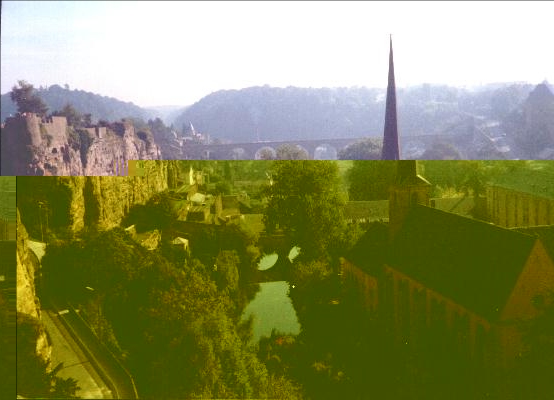
Venturing out of the city towards the north of the Grand Duchy the first town we will come across is Ettlebruck. Unfortunately I don't have a picture of the most interesting feature. At the side of the main road just outside town you will pass a carefully preserved and maintained Sherman Tank. This tank was the vehicle used by General Patton as he led the allied advance through this part of The Ardennes. Luxembourg suffered badly under Nazi oppression and both Patton and FDR are still revered by the people. As well as the Concourse named for the former President in Luxembourg City you will find on the opposite side of The Petrusse in the new town, Boulevard General Patton. Churchill too is commemorated, they are a fair minded people.
Further on we come to a small town that is typical of this part of the world, where Germany, France, Belgium and The Netherlands meet. Stop a while in Echternacht, have something to eat in one of the many restaurants and cafes around the square. The pastries and Gateaux are excellent. Apart from the attractiveness of the town itself there is one place to visit and two stories to tell.
Above Left: The Square in late summer.
Above Right: A conservatory in the grounds of the Echternacht convent. Anyone who has ever drunk a white wine branded "Blue Nun" has had some contact with the convent for the "Blue Nun of Echternacht," Sister Maria Magdelina spent much of her life here and was famed for her work among the poor and sick people of the area. She was buried in the convent grounds. Over a period of years rumours began to circulate attributing miraculous cures to the nun's spirit and her grave became a place of pilgrimage. When she was beatified years later her remains were exhumed for removal to the Cathedral of Cologne On opening the casket, the Archbishop and his attendants were surprised to see that although the body had been buried a century before it had hardly decomposed and the features of the Sister Maria were still recognisable. She was in due course made a saint.
The conservatory that stands in the grounds of the former convent was a favourite retreat for the composer Franz Schubert. In fact it was here that he did not finish his unfinished symphony.
A few kilometers on from Echternacht we take a right turn and head towards the German border. We are now in the area known as Petite Suisse, Little Switzerland. The landscape becomes more hilly and the neat, prosperous farms give way to forest. Rounding the shoulder of a hill we are presented with our first view of the Citadel of Vianden, made more spectacular by the suddenness of its appearance for we are less than a kilometer away. 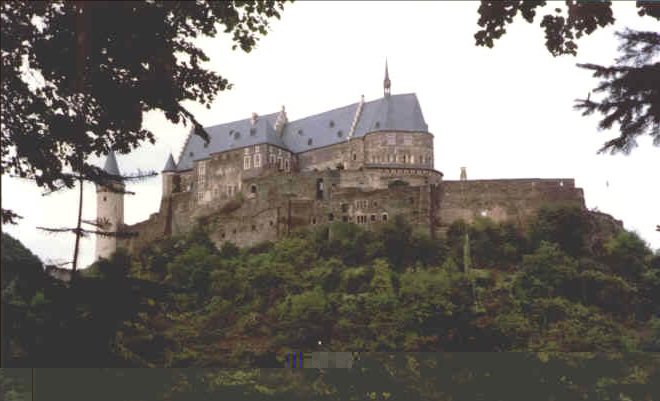 I cannot say when the Castle we see was built, there has been as fortification at this point since before history was recorded. It stands at a strategically important point and would have been a considerable obstacle to the French advancing north, The Prussians advancing south, the Bohemians advancing west, the Spaniards, who early in the seventeenth century ruled The Netherlands, advancing east into the Rhineland then ruled by the son - in - law of James 1 of Great Britain. The Spanish had wanted to avenge a perceived insult to their nation by James' son Prince Charles. Charles was betrothed to the Infanta (Princess) of Madrid but was not happy when the terms for marriage were laid out, basically because they virtually demanded that Britain would become a client state of Spain. There was no way the punters back home would accept that but Charles was besotted with the Infanta and decided he would climb the high wall of the Palace, free the girl and they would elope. This would have been a great idea but for the fact that the wall was very high and Charles was only four feet six tall. Needless to say the episode ended ignominiously. Vianden is a tourist spot now and other more modern attractions have grown up around the small town. The only one that appealed to me was the cable car ride which takes passengers to a viewpoint almost at the summit of the hill in the background. You will have to take my word that views over the valley are spectacular because I ran out of film and was not carrying a spare. 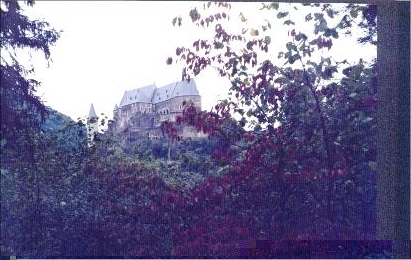
Considering we are less than an hours leisurely drive from the capital, a centre for international banking and finance, home of the European Courts of Justice and the Administrative headquarters of the European Union this part of the Grand Duchy is really in a different world. My two companions, Paul, a mixed race South African and Nizwar whose origins as his name suggests were in the Indian sub-continent although he is a British national, suggested we return through the country roads. It was OK, my car was a sporty hatchback and I liked driving the winding country lanes. One of the guys suggested we stop on the way for a meal so when we spotted a really authentic tavern I pulled into the car park and we went in.
The place fell silent and a room full of locals stared at us. It was like a scene from deliverance. Now none of us looked much like a Hollywood star or a pop idol so although a moments curiosity was understandable but the degree of attention was over the top. Being the only French speaker I went to the bar and while ordering drinks managed to catch one of the locals remarking on the unusual appearance of two of the strangers. Well we had already checked our flies and everything was in order so there could only be one thing. These people had never seen black men in the flesh before.
Carrying the three glasses back to our table I said "perhaps not a good thing to eat here boys, I think there is a good chance we might be on the menu." They saw the funny side of it and we all went into a surreal pastiche of those old movies about the British Empire.
"They're probably a frightened of us as we are of them chaps." Nizwar said.
"When we walk out keep looking the biggest one in the eye. They never attack until you show fear." I added.
"They can smell fear, they seem to feed on it." Paul said.
"What's that from?" we asked.
"Star Trek." he replied setting us all off giggling like schoolboys as we rose to leave.
As its the last night of your short break here let's head back to the city and I treat you in my favourite restaurant and then as my pictures were all taken in mid September we can spend an hour at the annual Shuberfoer, the main city fair held after the harvest season. 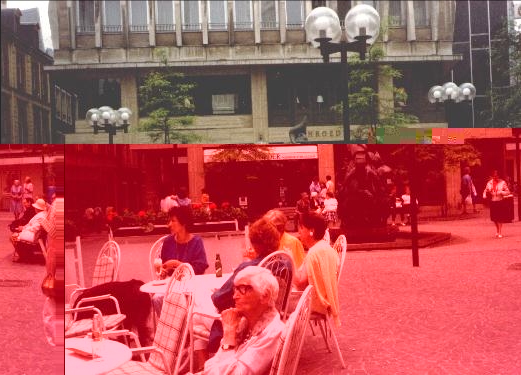 | 